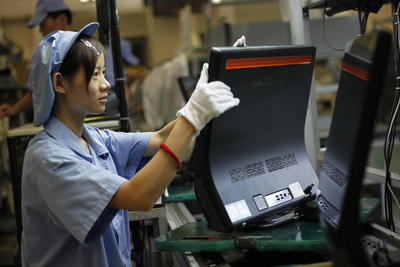Chinese ODI in manufacturing is quite different from that in other sectors. The main investors are private firms rather than state-owned enterprises (SOEs). And the majority of investments in manufacturing have gone to industrialised economies. Chinese manufacturing firms’ ODI is dominantly motivated by seeking technology and other strategic assets — mainly brand names.
Chinese multinationals rarely have firm-specific ownership advantages — notably, core technology, organisational and management skills, and brand names. What they do have is a variety of home-country specific advantages, such as financial support from the government and comparative advantage in certain labour-intensive industries.
Compared with ODI by industrialised countries half a century ago, Chinese firms today face totally different circumstances, characterised by globalisation in general and China’s integration into the world economy in particular.
Globalisation has meant the integration of national economies into a single global economy. This results in intense competitive pressures at home, with firms no longer able to shelter behind protectionist barriers. Private firms are thus strongly motivated to go abroad to strategically acquire assets such as research and development (R&D) facilities, technologies, brands, distribution networks and managerial competencies. This type of ODI is identified as ‘asset augmentation’ in contrast to traditional ‘asset exploitation’.
The success of Chinese manufacturing firms’ ODI rests with their capacity to consolidate and operate the acquired strategic assets, and with their ability to set up win-win relationships with not only target firms but also the local community in the host country.
In addition to seeking technology, brands and distribution networks, Chinese manufacturing ODI firms also have numerous other motivations. A big one is ‘institutional escapism’: many Chinese firms go abroad to avoid competitive disadvantages incurred by operating exclusively in the domestic market, such as regional protectionism, limited access to capital, lack of developed intellectual property rights and an under-provision of training and education. Market seeking is also a key driving force in ODI, as is the quest for natural resources and increased efficiency.
Chinese manufacturing firms use four strategies when seeking technologies and brand names.
The first is to set up overseas R&D centres. Establishing R&D subsidiaries, especially in industrialised countries, is not only conducive to accessing foreign technological assets, but also captures the externalities created by host-country technology clusters and centres of innovation. A second, related, strategy is setting up joint ventures with incumbent firms.
The third strategy involves mergers with and acquisitions of overseas firms. This strategy has become a common approach, largely because it provides rapid access to proprietary technology, brand names and quick establishment of R&D capabilities. The most well-known example is Lenovo’s US$1.75 billion purchase of IBM’s PC business in 2005. After the acquisition, Lenovo became the third-largest PC producer in the world.
The fourth strategy is ‘clustered going abroad’. This strategy is gaining importance among Chinese private small and medium enterprises (SMEs). Chinese private SMEs are small scale with widespread distribution and flexible operations. The Chinese government has played a critical role in helping these small firms to cluster their investments abroad by setting up overseas industrial, scientific and technological parks.
Despite the dramatic growth of Chinese ODI, the overall performance of those investing firms to date is not all that promising, with recent research indicating that only 30 per cent of Chinese ODI firms make a profit.
Investing abroad involves huge risks for any firm, and especially for Chinese firms. In cases where the firm lacks ownership or firm-specific advantages, they will struggle even when only seeking asset augmentation unless they can apply some unique, sustainable, resources and capabilities.
These resources and capabilities are positively associated with a firm’s absorptive capacity, which refers to the firm’s ability to recognise the value of new, external information, to assimilate it, and to apply it to commercial ends.
The biggest challenges pertain to post-acquisition difficulties. These include: how to build up win-win relationships with foreign stakeholders; how to reconcile different cultures at the national and corporate level; how to organise globally dispersed complex activities; how to deal with foreign regulators, unions, employees and local communities; how to absorb the acquired technology; and how to operate acquired brand names.
Chinese manufacturing firms do not have sufficient ability and experience in handling the above problems. The differences in institutional backgrounds between China and the host country make Chinese firms more likely to have conflicts with foreign stakeholders, local regulators, employees and communities over managerial philosophies, corporate culture, incentive schemes, leadership styles and formalised managerial procedures.
China is currently aiming to transform its growth model toward a more sustainable, inclusive and environmentally friendly pattern. Investing abroad is a valuable channel for realising this transformation. It also provides the incentive for the deepening of SOE reforms and for improving the competitiveness of China’s domestic private firms. Based on the experience of Chinese economic development, the key principles of gradualism, decentralisation and market-driven engagement should ensure that Chinese ODI takes on the best ‘Chinese characteristics’, and leaves behind the rest.
Dr Huiyao Wang is the inaugural Director-General at the Centre for China and Globalisation, Beijing.
Bijun Wang is a doctoral candidate at the China Centre for Economic Research, Peking University, Beijing.
Their research was presented at China Update 2011. The annual China Update conference is hosted by the China Economy Program, in collaboration with the East Asia Forum, at the ANU in July.
This article is a digest of their chapter, ‘Chinese Manufacturing Firms’ Overseas Direct Investment’, in Jane Golley and Ligang Song (eds), Rising China: Global Challenges and Opportunities (ANU E Press, 2011), available in pdf here. This book is the latest publication in the China Update Book Series, launched at the China Update conference every year.

